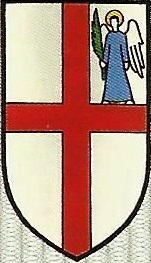Despotate Arta
The Despotate Arta ( Albanian Despotati i Artës ) was a despotate founded by Albanian princes in the 14th century . The despotate Arta existed from 1359 to 1416, when the Albanian princes Gjin Bua Shpata and Pjetër Losha defeated the despotate Epirus under the leadership of Nikephorus II. Dukas in the Battle of Acheloos .
history
Background and origin
In the spring of 1359, Nikephorus II Orsini, the last despot of Epirus of the Orsini dynasty , fought against the Albanians near the Acheron River in Aetolia . The Albanians won the Battle of Acheloos and managed to create two new states in the southern areas of the former despotate of Epirus. Since a number of Albanian lords actively supported the successful Serbian campaign in Thessaly and Epirus , the Serbian tsar granted them certain regions and offered them the Byzantine title of despot to ensure their loyalty.
In the late 1360s two Albanian principalities emerged: the first with its capital in Arta under Peter Losha and the second with its seat in Angelokastron under Gjin Bua Shpata. After the death of Peter Losha in 1374, the two Albanian states of Arta and Angelokastron were united under the rule of Gjin Bua Shpata.
In April 1378, the Grand Master Juan Fernández de Heredia set out to take Arta. However, he failed and was captured in battle by Gjin Bua Shpata. Heredia was sold to the Ottomans by Shpata for a large sum . Thomas II Preljubović , the despot of Epirus, offered valuable help during the battle, but this alliance did not last long.
The area of this despotate stretched in its greatest extent (1374-1403) from the Gulf of Corinth to the river Acheron in the north, adjacent to the principality of Gjirokastër by Gjon Zenevisi, another Albanian principality that was also founded in the area of the former despotate Epirus. During this time, the despotate Epirus managed to control only the eastern part of Epirus with the capital Ioannina . During this time, the despot of Epirus Thomas II Preljubović was in an open conflict with Gjin Bua Shpata. In 1375 Gjin Bua Shpata launched an offensive in Ioannina but was unable to enter the city. Although Shpata married Thomas' sister Helena, their war did not end.
Decline
After the death of Gjin Bua Shpata in 1399, the power of the despotate of Arta steadily weakened and the Shpata family became embroiled in civil affairs. Amid hostilities from various rulers, the despotate under the leadership of Jakob Bua Shpata (who converted to Islam ) fell, and Arta and Angelokastron were retaken.
Ruler
- Peter Losha (1359-1474)
- Gjin Bua Shpata (1359-1399) (In 1374, after the death of Peter Losha, the rule of both despotates)
- Skurra Bua Shpata (1400–1401)
- Muriq Shpata (1401-1415)
- Jakob Bua Shpata (1415-1416)
Today's legacy
In memory of the Albanian princes, many streets in Albania were named after them. The Despotate is also venerated by the Tschamans , as they still live in the north of Greece today. The Albanians, who today only make up a small minority, initially live together peacefully alongside Greeks and Aromanians .
Individual evidence
- ↑ Anamali, Skënder., Prifti, Kristaq., Instituti i Historisë (Akademia e Shkencave e Shqipërisë): Historia e popullit shqiptar në katër vëllime . Botimet Toena, Tiranë 2002, ISBN 99927-1-622-3 .
- ^ The Oxford Dictionary of Byzantium . January 1, 1991, doi : 10.1093 / acref / 9780195046526.001.0001 .
- ^ Fine, John VA (John Van Antwerp), 1939-: The late medieval Balkans: a critical survey from the late twelfth century to the Ottoman Conquest . 1st pbk. ed. University of Michigan Press, Ann Arbor 1994, ISBN 0-472-08260-4 .
- ^ Nicol, Donald MacGillivray .: The despotate of Epiros, 1267-1479: a contribution to the history of Greece in the Middle Ages . Cambridge University Press, Cambridge [Cambridgeshire] 1984, ISBN 0-521-26190-2 .
- ^ John W. Barker: The Despotate of Epiros, 1267-1479: A Contribution to the History of Greece in the Middle Ages. Donald M. Nicol . In: Speculum . tape 61 , no. 3 , July 1986, ISSN 0038-7134 , pp. 689-691 , doi : 10.2307 / 2851635 .
- ↑ ed. by Mathias Bernath: Biographisches Lexikon zur Geschichte Südosteuropas / 4, R - Z. Oldenbourg, Munich 1981, ISBN 3-486-42421-1 .
- ^ Ellis, Steven G., 1950-, Klusáková, Luďa., CLIOHRES.net (Research project): Imagining frontiers, contesting identities . Edizioni Plus, Pisa University Press, Pisa 2007, ISBN 88-8492-466-9 .


